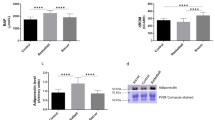Abstract
The physiological response to the physical exercise involves a number of changes in the oxidative balance and in the metabolism of some important biological molecules, including nitric oxide (NO) and heat shock proteins (Hsp 70). With the aim to optimise previous laboratory diagnostic panels, we measured the plasma concentration of reactive oxygen metabolites (ROMs), total antioxidant status (TAS), glutathione reductase (GR) activity, and NO and Hsp 70 levels in 44 elite, antioxidant-supplemented and trained soccer players and in 15 sedentary controls. Although no statistically significant difference between athletes and controls was detected in the plasma level of ROMs and TAS, soccer players showed a significantly higher plasma GR activity, NO and Hst 70 levels than those of sedentary controls. These findings suggest that the measuring of relatively novel biomarkers in sport medicine, like GR, NO and Hsp 70, in addition to the well-known and reliable assays (d-ROMs test and TAS) may be useful to a clinician to better assess and evaluate the benefits of training and/or supplementation programs.
Similar content being viewed by others
References
Alessio H (1993) Exercise-induced oxidative stress. Med Sci Sports Exerc 25:218–224
Banfi G, Dolci A, Verna R, Corsi MM (2004) Exercise raises serum heat shock protein 70 (Hsp70) levels. Clin Chem Lab Med 42:1445–1446
Brites FD, Evelson PA, Christiansen MG, Nicol MF, Basilico MJ, Wikinski RW, Llesuy SF (1999) Soccer players under regular training show oxidative stress but an improved plasma antioxidant status. Clin Sci 96:381–385
Erel O (2004) A novel automated direct measurement method for total antioxidant capacity using a new generation, more stable ABTS radical cation. Clin Biochem 37:277–285
Green DJ, Maiorana A, O’Driscoll G, Taylor R (2004) Effect of exercise training on endothelium-derived nitric oxide function in humans. J Physiol 561:1–25
Husain K, Somani Sm, Boley TM, Hazelrigg SR (2003) Interaction of physical training and chronic nitroglycerin treatment on blood pressure and plasma oxidant/antioxidant systems in rats. Mol Cell Biochem 247:37–44
Jableka A, Checinski P, Krauss H, Micker M, Ast J (2004) The influence of two different doses of L-arginine oral supplementation on nitric oxide (NO) concentration and total antioxidant status (TAS) in atherosclerotic patients. Med Sci Monit 10:29–32
Jay-Gerin JP, Ferradini C (2000) Are there protective enzymatic pathways to regulate high local nitric oxide (NO) concentrations in cells under stress conditions? Biochimie 82:161–166
Jungersten L, Ambring A, Wall B, Wennmalm A (1997) Both physical fitness and acute exercise regulate nit4ric oxide formation in healthy humans. J Appl Physiol 82:760–764
Kingwell BA, Sherrard B, Jennings GL, Dart AM (1997) Four weeks of cycle training increases basal production of nitric oxide from the forearm. Am J Physiol 272:H1070–H1077
Kingwell BA (2000) Nitric oxide-mediated metabolic regulation during exercise: effects of training in health and cardiovascular disease. FASEB J 14:1685–96
Maeda S, Miyauchi T, Kakiyama T, Sugawara J, Iemitsu M, Irukayama-Tomobe Y, Murakami H, Kumagai Y, Kuno S, Matsuda M (2001) Effects of exercise training of 8 weeks and detraining on plasma levels of endothelium-derived factors, endothelin-1 and nitric oxide, in healthy young humans. Life Sci 69:1005–1016
Maiorana A, O’Driscoll G, Taylor R, Green D (2003) Exercise and the nitric oxide vasodilator system. Sports Med 33:1013–1035
Metin G, Atukeren P, Alturfan AA, Gulyasar T, Kaya M, Gumustas MK (2003) Lipid peroxidation, erythrocyte superoxide-dismutase activity and trace metals in young male footballers. Yonsei Med J 44:979–986
Moseley PL (2000) Exercise, stress, and the immune conversation. Exerc Sport Sci Rev 28:128–132
Noble EG, Moraska A, Mazzeo RS, Roth DA, Olsson MC, Moore RL (1999) Differential expression of stress proteins in rat myocardium after free wheel or treadmill run training. J Appl Physiol 86:1696–1701
Quian ZM (2002) Nitric oxide and changes of iron metabolism in exercise. Biol Rev Camb Philos Soc 77:529–536
Repetto M, Reides C, Gomez-Carretero ML, Costa M, Grienberg G, Llesuy S (1996) Oxidative stress in blood of HIV-infected patients. Clin Chim Acta 255:107–117
Sacheck JM, Blumberg JB (2001) Role of vitamin E and oxidative stress in exercise. Nutrition 17:809–814
Schippinger G, Wonisch W, Abuja PM, Fankhauser F, Winklhofer-Roob BM, Halwachs G (2002) Lipid peroxidation and antioxidant status in professional American football players during competition. Eur J Clin Invest 32:686–692
Tauler P, Aguilo A, Fuentespina E, Tur JA, Pons A (2002) Diet supplementation with vitamin E, vitamin C and beta-carotene cocktail enhances basal neutrophil antioxidant enzymes in athletes. Pflugers Arch 443:791–797
Trotti R, Carratelli M, Barbieri M (2002) Performance and clinical application of a new, fast method for the detection of hydroperoxides in serum. Panminerva Me 44:37–40
Vassalle C, Lubrano V, Domenici C, L’Abbate A (2003) Influence of chronic aerobic exercise on microcircolatory flow and nitric oxide in humans. Int J Sports Med 24:30–35
Wang J, Brown MA, Tam SH, Chan MC, Whitworth JA (1997) Effects of diet on measurement of nitric oxide metabolites. Clin Exp Pharmacol Physiol 24:418–420
Wang XL, Rainwater DL, VandeBerg JF, Mitchell BD, Mahaney MC (2001) Genetic contributions to plasma total antioxidant activity. Arterioscler Thromb Vasc Biol 21:1190–1195
Woodman CR, Muller JM, Laughlin MH, Price EM (1997) Induction of nitric oxide synthase mRNA in coronary resistance arteries isolated from exercise-training pigs. Am J Physiol 273:H2575–H2579
Acknowledgements
This study was funded by grants awarded by FIRST-MIUR. We are grateful to Ms. J. D. Baggott for English editing, and to RANDOX Ltd Italia for TAS and GR assay kits.
Author information
Authors and Affiliations
Corresponding author
Rights and permissions
About this article
Cite this article
Banfi, G., Malavazos, A., Iorio, E. et al. Plasma oxidative stress biomarkers, nitric oxide and heat shock protein 70 in trained elite soccer players. Eur J Appl Physiol 96, 483–486 (2006). https://doi.org/10.1007/s00421-005-0104-6
Accepted:
Published:
Issue Date:
DOI: https://doi.org/10.1007/s00421-005-0104-6




